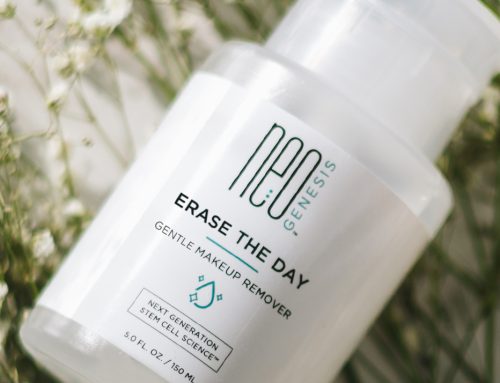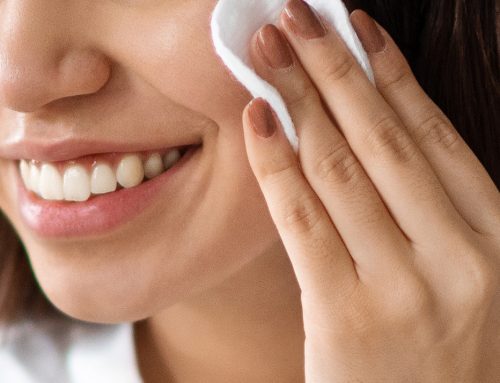Isopropyl Myristate is Non-Comedogenic
By: Dr. Greg Maguire, Ph.D.
Are you afraid of recommending makeup remover to clients because it might clog their pores? You are not alone. For decades, the beauty industry has been trying to understand which ingredients are comedogenic, or likely to clog pores. Unfortunately, the traditional methods used for testing have been outdated and even unethical. In this article, we’ll take a look at the flaws of these tests and ultimately debunk the myth about Isopropyl Myristate, which is a non-comedogenic ingredient. We will look specifically at the NeoGenesis Erase The Day makeup remover and demonstrate that it is a non-comedogenic product.
NeoGenesis Erase the Day: Makeup Remover is a safe and effective makeup remover that features carefully chosen ingredients and is non-comedogenic.
Scientists have confirmed in peer-reviewed publications that Isopropyl Myristate, an ingredient in the product, is actually non-comedogenic, despite some misconceptions that it is comedogenic (Lee et al, 20150). All of the ingredients used are ranked low in the Environmental Workgroup’s (EWG) analysis of an ingredient’s induction of cancer, allergies & immunotoxicity, and developmental and reproductive toxicity.
The EWG’s analysis of Isopropyl Myristate gave it a “1,” the lowest ranking on a 10-point scale for causing all these 3 concerns and included no use restrictions.
NeoGenesis Makeup Remover is not comedogenic for two key reasons:
- Isopropyl Myristate itself is non-comedogenic (Lee et al, 2015)
- Even if Isopropyl Myristate were comedogenic, the way NeoGenesis Erase The Day makeup remover is used as a product that is immediately washed-off, would not be comedogenic.
As Dr. Zoe Draelos, M.D., a board-certified dermatologist has published in a peer-reviewed journal, “Finished products using comedogenic ingredients are not necessarily comedogenic” (Draelos and DiNardo, 2006). Whether an ingredient is comedogenic depends on many factors, including how the ingredient is used, such as is it left on the skin or washed-off, and the concentration of the ingredient, as well as what is the formulation in which the ingredient is used. In a formulation, some so-called comedogenic ingredients will be rendered non-comedogenic by other ingredients in the formula.
How was the myth about Isopropyl Myristate started, and why has it been propagated in the media and online?
To understand the flaws in the comedogenic scale we need to know how these tests are performed. Kligman and Mills created a test in 1972 using rabbit ears to study how certain ingredients can clog skin pores. They applied test ingredients to the canals of the rabbits’ ears for two weeks and examined whether the pores were clogged. They found that 50% of the 25 facial cosmetic creams they tested were mildly comedogenic in the rabbits’ ears, which sparked the discussion around comedogenicity.
Ten years later, in 1982, Mills and Kligman developed a human model to test substances by applying them to the upper part of the backs of young men with large follicles. The substances were applied using an occlusive dressing for one month. The problem is the occlusive dressing alone can have negative effects such as increased absorption and penetration of the product, potentially resulting in more comedones. The removal process involved using a “cyanoacrylate glue” to remove the substances from the skin. Cyanoacrylates can cause contact dermatitis, i.e. irritation (Bitterman and Sandhu, 2017). This process drastically skewed the results and lead to misleading false-positives.
This flawed methodology has lead to the unfortunate spread of misinformation regarding the true status of an ingredient as comedogenic or non-comedogenic. Seeking out and understanding more modern tests (like the EWG’s analysis) is essential to understanding how our scientific knowledge about these ingredients has evolved.
Final Takeaways about Isopropyl Myristate and NeoGenesis Makeup Remover
My take home from these studies is that I will not place Isopropyl Myristate on the ear canal of my pet rabbit for 24 hours straight, every day of the week, for one month because I don’t want my rabbit to have mildly clogged pores in his ears. I will, however, recommend using Neogenesis Makeup Remover to friends and loved ones that is quickly applied to the areas of the skin where makeup needs to be removed, and then using a gentle cleanser, such as NeoGenesis Cleanser, to wash away the Makeup Remover from the skin.
NeoGenesis Erase the Day: Makeup Remover provides a safe and healthy alternative from the harsh ingredients present in many other makeup removers available on the market today.
As the American academy of Dermatology recommends, “Remove your makeup, including eye makeup, before going to bed. Use an oil-free makeup remover. After removing your makeup, wash your face with a gentle cleanser. Avoid scrubbing your face, even when removing makeup.” Your pores will thank you for having gently unclogged them of that makeup you applied in the morning.
And you don’t have to worry about reclogging them with this product, either.
References
Bitterman A, Sandhu K. Allergic contact dermatitis to 2-octyl cyanoacrylate after surgical repair: Humidity as a potential factor. JAAD Case Rep. 2017 Sep 23;3(6):480-481.
Draelos ZD and DiNardi JC (2006) A re-evaluation of the comedogenicity concept. JAAD, 54, ISSUE 3, P507-512.
Kligman AM, Mills OH. “Acne Cosmetica”. Arch Dermatol. 1972;106(6):843–850. doi:10.1001/archderm.1972.01620150029011
Lee E. et al (2015) Isopropyl Myristate and Cocoa Butter are not Appropriate Positive Controls for Comedogenicity Assay in Asian Subjects. J Cosmo Trichol 2015, 2:1.
Mills OH Jr, Kligman AM. A human model for assessing comedogenic substances. Arch Dermatol. 1982 Nov;118(11):903-5. PMID: 7138047.
Do you want to learn more about what NeoGenesis products can do for you? Follow NeoGenesis on Facebook, Instagram, TikTok, Twitter and YouTube.

NeoGenesis Australia
+61 (2) 82033339
info@NeoGenesisPro.com.au
www.NeoGenesisPro.com.au




